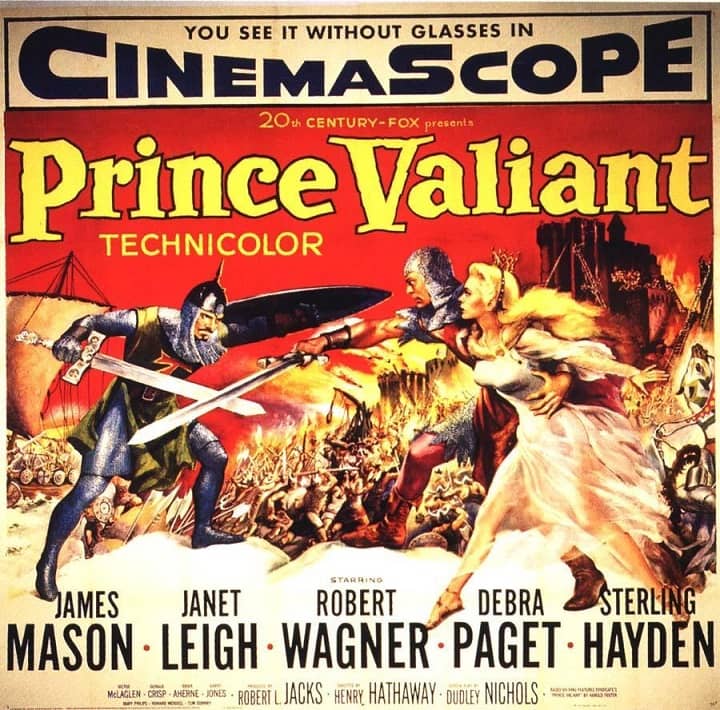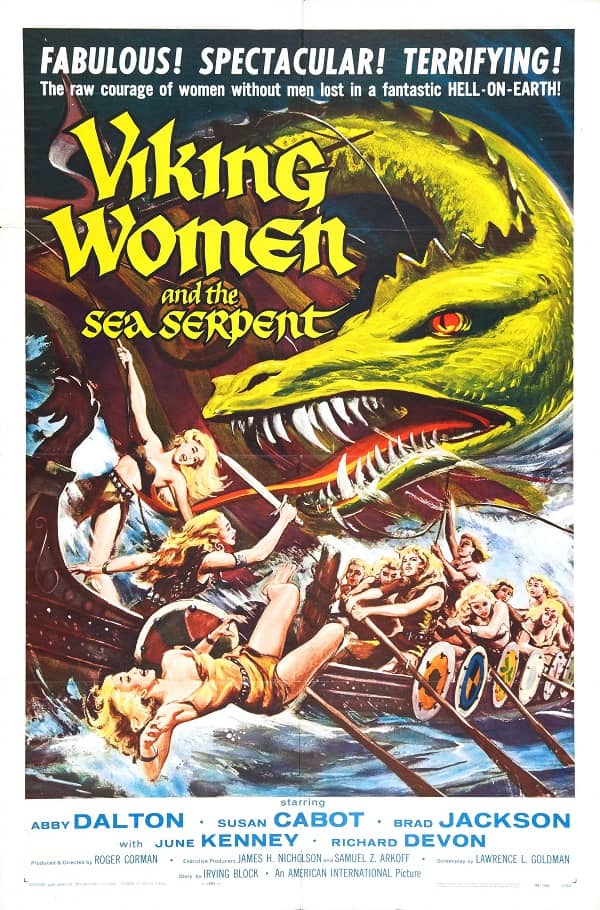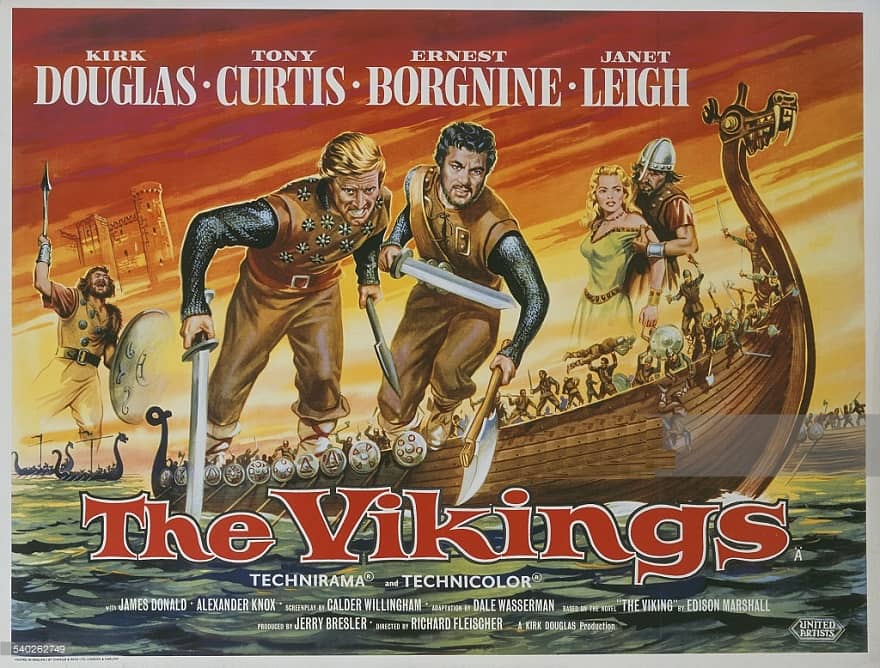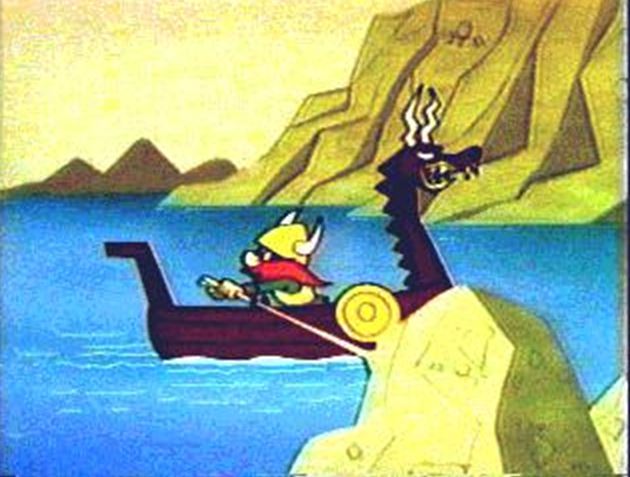Ellsworth’s Cinema of Swords: ‘50s Vikings – Havoc in Horned Helms
Since the resurgence in interest in the Norse and their far-traveling raiders during the Romantic era of the early 19th century, the depiction of Vikings in popular culture had been pretty consistent, as a bunch of rugged, hard-drinking, manic-depressive berserkers with a lust for life and horns on their helmets. But except for the silent epic The Viking (1928) they didn’t really get a lot of Hollywood screen time until the 1950s, when a few films established or burnished the visual tropes that are still touchstones today. Here are three movies that demonized, caricatured, and lionized the Vikings—and it was the last, which valorized them on a grand scale, that made the most lasting impression.
Prince Valiant
Rating: ***
Origin: USA, 1954
Director: Henry Hathaway
Source: 20th Century Fox DVD
When I was a kid, Sunday morning meant the eagerly awaited color comics section of the Akron Beacon Journal, and the comic I always turned to first was Prince Valiant. Hal Foster’s adventure tale, set “In the Days of King Arthur,” was gorgeously designed, told an endless story of nearly adult caliber, had engaging characters, was epic in scope and yet ambitious in its attempt to get the details of medieval life credible and accurate. (Its historical setting was highly fictitious, of course, but the Arthur tales are legend, not history.) Prince Valiant was arguably the greatest American adventure strip of the 20th Century.
The movie adaptation is… not as great. However, it’s also not nearly as terrible as its reputation, which rests mainly on how doofy Robert Wagner looked in a black page-boy wig, and how badly miscast the talented Sterling Hayden was as Val’s mentor, Sir Gawain. The rest of the cast was quite good, led by James Mason as the treacherous Sir Brack and Janet Leigh as the feisty Aleta, backed up by Debra Paget as Princess Ilene and the ursine Victor McLaglen as Boltar the Viking. The direction by Henry Hathaway was solid, especially in the action sequences, and Franz Waxman delivered his usual top-notch score.
So why is this movie so roundly sneered at? Its problems are twofold. First, it seems somebody thought that because it was adapted from a comic strip its tone needed to be juvenile, like a boy’s-own-adventure book with everything clichéd and obvious. Second, though there’s nothing more English than King Arthur and the Knights of the Round Table, there was nobody more gosh-darned American than Sterling Hayden and Robert Wagner (unless it was Tony Curtis, who almost got Wagner’s part). Every time they open their mouths, you hear New Jersey.
The first two-thirds of the movie are basically a standard Hollywood squire-learning-to-be-a-knight picture, though with dialogue that’s even worse than usual. The only twist on the formula is that Val is a Viking prince from “Scandia” (clever, eh?), so there’s extra snobbery because he’s a northern barbarian. The flick briefly turns into a silly romantic farce when both Val and Gawain fall for Aleta, and for twenty cringe-worthy minutes the movie looks doomed — until James Mason saves the day by being a right evil scheming bastard.
Literally. Though illegitimate, Sir Brack has royal blood, and he’s been plotting to usurp Arthur’s throne. Brack’s cut a deal with the wicked Viking Sligon — the same brute who deposed Val’s father, which is why he sent Val to Camelot — a deal to lend Brack a Viking army in exchange for Prince Valiant, the last heir to Sligon’s stolen throne. The scheming Sir Brack tricks Val into leaving Camelot, he’s captured and taken to Scandia….
…And suddenly it’s like we’re in a whole different movie, an exciting action-adventure that’s not doofy at all. Val, his parents, and Aleta (who’d gone after him) get clapped by Sligon into a grim dungeon, condemned to be first tortured and then crucified. Boltar is outside in the town rallying the loyal Vikings to attack Sligon’s castle and save their true rulers, but the effort is doomed without someone on the inside to change the odds. Val, locked in a dungeon cell with no way out, suddenly transforms from a patsy into the bold and clever trickster of the comic strip — it’s like a switch got flipped. In a thrilling extended action sequence, Val escapes from his cell, signals the loyal Vikings to attack, drenches half of Sligon’s defenders in their own flaming whale oil, duels Sligon to the death for possession of the Singing Sword, his birthright, and frees his parents and Aleta before the burning fortress can collapse on top of them. It’s brilliant. After that, returning to Camelot to challenge Sir Brack to trial-by-combat seems almost an afterthought.
As a final aside, let’s take a moment to address the controversial-yet-hilarious subject of horned helmets. They’d been part of the popular image of Vikings since Wagner’s operas, and there had been quite a few modestly horned helms in the 1928 cinema epic The Viking, despite historians finding little or no evidence for them. Since Prince Valiant was a Nordic prince there were plenty of Vikings in Foster’s comic strip, though the only character to sport a prominently horned helm was Boltar, whose role was, after all, to be a larger-than-life jovial giant. But the costume designers on the feature film seemingly looked at Boltar’s headgear and decided that was the way to go, and boy howdy, did they go there: so many horned heads! When the Vikings come ashore in Prince Valiant it looks like a stampede of longhorn cattle. It’s kind of adorable.
Viking Women and the Sea Serpent
Rating: *
Origin: USA, 1957
Director: Roger Corman
Source: Lionsgate DVD
Warning: here are sixty-five minutes you’ll never have again. In the late fifties, movies about giant monsters were all the rage, many of them produced by the shlockmeisters at American International Pictures, and filming a bevy of half-clad starlets had never gone out of style, so the young producer-director Roger Corman combined the two in this shoddy would-be epic. Its pompously overlong full title is The Saga of the Viking Women and their Voyage to the Waters of the Great Sea Serpent, which is the only thing the least bit clever about this dud.
Let’s get right to what passes for its story: in Norway, which you probably never realized looks exactly like southern California, at a village whose men went off a-Viking and never returned, the women left behind are voting on whether to go search for them, using the traditional Nordic method of hurling their spears into the “Yes” tree or the “No” tree. The deciding “Yes” vote is cast by the priestess Inger, the only non-blonde, who is suspected of wanting to go on the mission so she can get her hooks into one of the missing men, a Viking who belongs to the blonde woman with the ponytail. (None of the blonde women have been granted distinctive personalities or dialogue, alas, so the only way to tell them apart is by hairstyle.)
The women go to sea in a cheesy-looking fake longship, a prop so crappy that pieces are visibly falling from it as it’s launched. (Apparently while filming, the whole crew of Viking women damn near drowned when the guy piloting the towboat fell asleep and they were all carried far offshore.) Once they’re at sea the only subject the women want to talk about is men, so you know this is a fantasy. Fortunately, the only man left in their town, a shirtless blond surfer dude, has stowed away and gone with them, so there’s a responsible male on board who can make important decisions and deliver key exposition like, “It’s the monster of the vortex!” Said monster is the worst sea serpent ever back-projected in Hollywood, but it’s monstrous enough to swamp the crappy longship, which for good measure is set afire by a gratuitous lightning bolt. The crew abandon ship, and we’re treated to the sight of a flaming six-inch model of an entirely different vessel as it swirls down into a tiny whirlpool.
The crew wash ashore somewhere on the coast of Malibu, where they’re promptly captured by a tribe of mounted barbarians and marched off to an unconvincing matte painting of a generic castle. There the barbarian chief tells them with a leer that they are now slaves who must do whatever the barbarians wish — but first there must be a boar hunt! And immediately the Viking women are given horses and spears and off they all go. (Don’t ask about the sad fake-tusked porker that plays the boar.)
The rest of the film makes just as much sense. There’s a rowdy feast with 1950s “exotic” dancing, gratuitous woman-whipping, escape, betrayal by Inger (never trust the dark-haired one!), recapture, reunification with the lost and enslaved Viking men, more escape, more recapture, and a flaming sacrifice of the Vikings to the barbarian gods that gets snuffed out in a literal deus ex machina when Inger redeems herself by calling on the god Thor to save them. That leaves only the final battle with the titular sea serpent, who has apparently been able to terrorize the coast of Malibu for generations because nobody ever thought to stick a sword in its head. Well, I never.
The Vikings
Rating: *****
Origin: USA, 1958
Director: Richard Fleischer
Source: KL Studio Classics Blu-ray
You can complain about parts of this film if you want to — and with lines like, “Love and hate are just horns on the same goat,” you’ve got a point — but on the whole, The Vikings is a superb swashbuckling extravaganza, a production bursting with verve and enthusiasm, serious entertainment that never takes itself too seriously. It’s a hell of a good time, and nobody had more fun making it than its producer and star, Kirk Douglas, who buoys it up with sheer gusto whenever it threatens to get too pompous.
The gusto starts right in the opening credits where, instead of setting the historical scene with scrolling text that reads like something from the King James Bible, the film opens with a colorful animated storyboard depicting the depredations of the Vikings on the English coast. It’s based stylistically on the Bayeux Tapestry and narrated (without credit) by Orson Welles, and more a classy cartoon than an illuminated manuscript. It runs just long enough and then the film dives right into the action, cutting from cartoon Vikings to the real thing, murdering and pillaging in English Northumbria. They’re led by the cheerfully ruthless King Ragnar (Ernest Borgnine), who callously rapes the local queen (the camera cuts away) and leaves her with child.
The movie then slows down for some exposition and the passage of twenty years, after which we’re reintroduced to Ragnar and meet his son Prince Einar (Douglas, actually two months older than papa Borgnine), as well their English slave Eric (Tony Curtis), who unbeknownst to all is the son Ragnar begot on the Northumbrian queen — and thus Einar’s half-brother.
The movie’s final lead is the English Princess Morgana (Janet Leigh, Curtis’s wife at the time), who gets abducted a lot. She’s the love interest for both Einar and Eric and she looks great, but unfortunately isn’t given a lot to do other than to fail at teaching Einar the concept of romantic consent.
The three male leads really throw themselves into this fateful love triangle, acting their guts out — yes, Curtis could act — but they’re almost overshadowed by the magnificence of the background their conflict is staged against. The production is splendid, shot in eye-poppingly gorgeous Norwegian fjords and on the coast of Brittany, and the costumes and sets are first-rate. They built a couple of fully functional Viking longships for the movie as well as several smaller vessels, and they weren’t shy about putting them through their paces and showing you exactly how they worked. They also constructed an authentic Norse village with a capacious mead-hall (we see a lot of the mead-hall), the look of which, bold and rustic, defined the Viking era for a generation. (And beyond: you’ll see echoes of this film even in the video game Skyrim.) Add a bombastically memorable score by composer Mario Nascimbene, and you’ve got an audiovisual feast it would be hard to forget.
And now let us praise director Richard Fleischer, whom Douglas had met when shooting 20,000 Leagues for Disney, and for whom Vikings was a career-making film. And rightly so: every shot is carefully composed, and every scene builds to maximum impact. This is as true for the action sequences — of which there are plenty — as for the scenes of sheer spectacle. For example, when Einar’s ship returns in triumph to the home fjord, the crew, led by Douglas himself, “run the oars” by hopping above the waves along the row of outstretched timbers from stern to bow. It’s both exciting and hilarious. (This was an actual historical feat that no one had attempted for nearly a thousand years, and only the stuntmen were supposed to do it for the shot, but nobody could keep the grinning and athletic Douglas from joining in.)
We’ll skip the details of the plot, which is the standard Viking-saga mélange of attacks, abductions, arson, and amputation, and jump right to the final battle, where rivals Einar and Eric must team up to lead an assault on the castle of the treacherous English king who’s captured Morgana. The whole prelude to this battle is silent except for the pounding of drums as the Vikings disembark from their longships, arm, and prepare for the attack. Fleischer borrows liberally from Eisenstein’s Alexander Nevsky and it pays off, the suspense building and building until the Norsemen are released to descend like a storm on the seemingly invulnerable fortress. Some top-notch gymnastic swashbuckling gets the Vikings through the castle’s gates, and then the battle dissolves into convincingly bloody chaos. And yet, thrilling as this is, the whole sequence is really just a set-up for the final confrontation between Einar and Eric that resolves the long-simmering romantic rivalry. It’s tremendous.
A final note on tone: unlike most Hollywood epics of the big-studio era that featured conflicts between Christians and pagans, this movie is a sea change in that for once the vigorous, larger-than-life Odin worshippers win the day, ultimately triumphing over their effete Christianized adversaries. These Vikings are a warrior folk who live in a world ruled by doom and fate, and that gives them the strength to embrace whatever fate sends them. Which doesn’t make them admirable — but it does show why they were so often victorious.
But let’s end this article on an up note! Close this article right now and go watch the classic Looney Tunes Prince Violent (1961). That’s all, folks!
Additional installments in the Cinema of Swords:
Olivia de Havilland — First Queen of the Swashbucklers
Goofballs in Harem Pants
Disney’s Early Swashbucklers
‘50s Vikings – Havoc in Horned Helms
Laughing Cavaliers
Charming and Dangerous: Douglas Fairbanks, Jr.
LAWRENCE ELLSWORTH is deep in his current mega-project, editing and translating new, contemporary English editions of all the works in Alexandre Dumas’s Musketeers Cycle. Three volumes are in print, with the fourth, Blood Royal, coming from Pegasus Books this fall. His website is Swashbucklingadventure.net.
Lawrence Ellsworth’s secret identity is game designer LAWRENCE SCHICK, who’s been designing role-playing games since the 1970s. He now lives in Dublin, Ireland, and is co-designing a new mobile RPG for the WarDucks game studio.




Well, I love Roger Corman and I think Viking Women and the Sea Serpent is…well, fabulous, spectacular, and terrifying. But not in that order.
I enjoyed all three of these movies as a boy.
Ditto, Mr. Ellsworth regarding Prince Valiant, both the comic strip and the movie, although I didn’t pick up on how much of split personality the film had until I rewatched it as an adult.
Abby Dalton…Susan Cabot…sigh.
My own favorite (although it’s actually from the 1960s) is The Long Ships, starring Richard Widmark, Sidney Poitier and Russ Tamblyn. It’s ostensibly based on the novel of the same name by Frans Bengtsson although when I read the novel I don’t recall anything remotely resembling the film, in which Widmark and Tamblyn go searching for a mythical giant bell and run into Poitier down in Moorish Spain, I believe.
One of the movies that I remember first seeing on television when I was visiting my grandparents in California, and I remembered some images & scenes, but never knew what the film was actually called until decades later.
Prince Valiant is the one I still find watchable. (Well, to be honest, I’ve never watched Viking Women and the Sea Serpent, but having watched the trailer, I’m pretty comfortable in passing.)
If you want goofy horned helms, and you’re willing to skip ahead a couple of decades, I suggest The Norseman, starring Lee Majors. Those helms put the ones in Prince Valiant to shame!
THE VIKINGS is a great movie. I’ve actually got it on DVD and watch it every couple of years.
I find it odd that the cast is almost one for one the same cast of SPARTICUS. I’m sure there’s a story there.